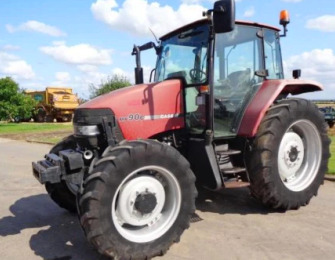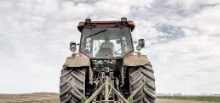________________________________________________________________________________________
| Home / Farm Tractors / Case IH Tractors / Case IH MX90C |
Case IH MX90C Troubleshooting
 The
Case IH MX90C utility tractor was manufactured between 1998 and 2002. The
tractor is powered by 244 cu.in (4 L) Perkins 1004-4T 4-cylinder direct
injection turbocharged diesel engine with a rated power of 90 hp (67.1 kW).
The
Case IH MX90C utility tractor was manufactured between 1998 and 2002. The
tractor is powered by 244 cu.in (4 L) Perkins 1004-4T 4-cylinder direct
injection turbocharged diesel engine with a rated power of 90 hp (67.1 kW).
The Case IH MX 90 C is fitted with a 2 types of transmission. Type 1: 16x12 partial powershift transmission. Type 2: 32x24 partial powershift transmission with creeper. The maximum travel speed (forward/reverse): 23 mph (37 kph) and 13.7 mph (22 kph). The closed center pressure flow compensated hydraulic system has a pump with a rated capacity of 25 gpm (94.6 lpm).
The hydraulic system pressure is 203 bar (2950 psi). The Case IH MX90C tractor is equipped with a hydrostatic power steering system, differential hydraulic wet disc, 14.9x24 front tyres, and 18.4x34 rear tyres. The wheelbase is 95.4 in (2420 mm).
| Engine Troubleshooting |
| Engine difficult to start or won't start |
There is air in the fuel system - Bleed the system.
Fuel filter plugging - Change filter element.
Clogged injection nozzle - Replace injection nozzles.
Water in the fuel system - Change fuel and repair fuel system.
The valve clearance is not adjusted - Correct valve clearance.
Fuel injection pump is defective - Install a new fuel pump or repair.
| Diesel starts but then stops |
Plugged air filter - Clean or replace element.
Fuel filter element clogging - Clean or replace the filter.
Fuel injection pump has loose connections - Tighten the connections.
Defective fuel injectors - Replace fuel injectors.
Damaged fuel injection pump - Install a new fuel pump or repair.
| Engine stalls during operation |
Low coolant temperature - Warm up the engine.
Fuel filter plugging - Clean the filter or install new filter element.
Air trapped in fuel system - Bleed air.
Fuel injection nozzles are damaged or dirty - Check injection nozzles and replace if required.
Improper fuel injection timing - Set up as recommended.
| Engine stalls at idle |
Wrong adjustment of low idle speed - Normalize low idle speed.
Fuel injection pump is faulty - Install a new fuel pump or repair.
Dirty or defective injectors - Clean fuel injectors or change it.
Incorrect valve clearance - Adjust valve clearance.
| Engine power is too low |
Dirty air filter element - Service air cleaner.
Dirty or faulty injection nozzles - Test injection nozzles and change if necessary.
Fuel injection pressure is wrong - Check the fuel injection pressure and adjust if necessary.
The valve clearance is not adjusted - Correct valve clearance needs to be set.
Incorrect low idle setting - Correct low idle settings.
Dirt in the fuel hoses or lines - Clean fuel system lines and hoses.
Defective cylinder head gasket - Install a new gasket.
Piston rings are broken or leaking - Replace piston rings.
| Engine overheated |
Low coolant level - Refill to the correct level and inspect system for leaks.
Lack of engine oil - Fill the crankcase with engine oil.
Clogged radiator core or leaking radiator cap - Clean radiator or change cap.
Fan belt slipping or worn - Belt replacement is recommended.
Engine overload - Load reducing required.
| Low oil pressure |
Lack of oil - Add oil to the engine crankcase.
Oil filter clogged - Replace or service engine oil filter.
Incorrect oil viscosity - Fill up with the correct oil viscosity.
Incorrect crankshaft bearing oil clearance - Replace bearings.
Oil pump is worn or damaged - Remove and inspect oil pump.
| Engine knocks or noises |
Lack of engine oil - Fill up the oil to required level.
Coolant temperature is low - Normalize the temperature by warming up the engine.
Incorrect adjustment of fuel injection pump timing - Adjust as recommended.
Too low idle RPM - Need to adjust idle speed.
Fuel injectors are faulty or clogged - Clean fuel injectors or change it.
Connecting rod is defective or not aligned - Connecting rod needs to be aligned or changed.
Worn or scored pistons - Pistons need to be replaced.
| Transmission Troubleshooting |
| Insufficient transmission oil pressure |
Lack of transmission fluid - Check and refill the transmission fluid.
Dirty transmission fluid filter element (if equipped) - Service or replace the transmission fluid filter.
Defective relief valve - Replace relief valve as required.
| Transmission noises |
Transmission oil insufficient - Need to add transmission oil.
Transmission fluid is dirty - Change the fluid.
Gears are damaged or backlash is incorrect - Change worn gears or adjust backlash correctly.
Worn or damaged bearings - Faulty bearings should be replaced.
Shift forks are bent or worn out - Replace the shift forks.
Stuck or worn shaft splines - Change the shaft.
| Hard to shift gears |
Rusty or worn gear shift linkage - Change or lubricate shift linkage.
Shift forks are bent or worn out - Shift forks need to be replaced.
Defective parts in the gearshift mechanism - Replace defective parts.
Worn or improperly adjusted clutch - Change or adjust clutch.
| Transmission fluid leaks |
Too much oil in transmission - Drain the excess oil.
Broken seals or gaskets - Replace worn seal or gaskets.
| Hydraulics Troubleshooting |
| Hydraulic fluid pressure is low |
Hydraulic fluid level low - Fill the system to proper hydraulic fluid level.
Clogged hydraulic oil filter - Hydraulic filter maintenance required.
Hydraulic pump failure - Replace or repair hydraulic oil pump.
Hydraulic control valve block is out of adjustment - Control valve needs to be adjusted.
Hydraulic cylinder is broken - Change or repair hydraulic cylinder.
Leaking hydraulic pipes - Find leaks in the system and fix it.
| Hydraulic system overheated |
Damaged main relief valve - Replace relief valve.
Hydraulic oil type is improper - Fill up with the proper type of oil.
Hydraulic oil is dirty - Hydraulic oil change required.
Air in hydraulic system - Bleed air from hydraulic system.
| Hitch can't lift or lifts too slowly |
Excessive loading on the hitch - The load should be reduced.
Insufficient hydraulic fluid - Fill up the hydraulic fluid.
Hydraulic oil filter is clogged - Clean or replace the hydraulic filter.
Hydraulic pump is defective - Repair or replace hydraulic fluid pump.
Faulty main relief valve - Install a new relief valve.
Defective hydraulic control valve block - Replace or repair the valve.
Damaged hydraulic cylinder - Replace or repair hydraulic cylinder.
Suction line is disconnected or broken - Replace or connect correctly.
| 3-point hitch won't lower or lowers slowly |
Incorrect setting hydraulic control valve - Use the correct adjustment.
Hydraulic cylinder failure - Repair or change hydraulic cylinder.
The three-point hitch is not adjusted - Need to make adjustments.
Worn hitch cross shaft - Change the shaft.
| Hitch jerks when drop or lift |
There is air in the hydraulic system - Bleed hydraulic system.
Contaminated hydraulic fluid - Change hydraulic fluid.
Hydraulic pump not working - Repair or replace hydraulic fluid pump.
Defective hydraulic control valve - Replace or repair the valve.
Damaged hydraulic cylinder - Repair or replace hydraulic cylinder.
| Steering Troubleshooting |
| Steering wheel is hard to turn |
Defective or incorrectly mounted steering column - Change steering column or mount correctly.
Air trapped inside steering system - Bleed the system of air.
Incorrect toe-in - Check toe-in and correct.
Front tires are worn unevenly - Install new tires.
Steering pump is worn - Check the steering pump and replace if necessary.
Stuck or damaged steering pump control valve - Flush or change flow control valve.
Not enough steering oil - Check oil level and add steering oil as required.
| Steering wheel has too much free-play |
Steering column coupling or shaft is extremely worn out - Change faulty part.
Damaged hydraulic steering pump - Repair or replace steering pump.
Worn or loose steering linkage joints - Repair or replace steering linkage.
| Tractor pulls to right or left |
Uneven wear on front tyres - Replace the tyres.
Incorrect toe-in - Adjust toe-in properly.
Loose or worn steering linkage parts - Repair or replace steering linkage.
Front wheel bearings are damaged or incorrectly adjusted - Change or adjust bearings correctly.
| Electrical Troubleshooting |
| Battery will not charge |
Electrical cable connections are loose or corroded - Tighten or clean connections.
Electrical terminal connectors are defective - Terminal connectors need to be changed.
Battery bad cell - Install a new battery.
Loose or defective belt - Adjust belt tension or change the belt.
| Starter turns slow |
Battery voltage is low - Battery is drained, recharge it.
Battery will not hold charge - Battery needs to be serviced or replaced.
Corroded battery terminals or disconnected wires - Check cable connections and change or clean terminals.
| Starter will not crank |
Battery is discharged or worn - Recharge or change battery.
Battery wires are disconnected or incorrectly connected - Check wires and connect correctly.
Low battery output - Battery is drained, recharge it.
Faulty starter motor - Starter needs to be replaced.
________________________________________________________________________________________
________________________________________________________________________________________
| Farm Tractors Technical Specifications |
